Ficus
Ficus (/ˈfaɪkəs/[1] or /ˈfiːkəs/[2][3]) is a genus of about 850 species of woody trees, shrubs, vines, epiphytes and hemiepiphytes in the family Moraceae. Collectively known as fig trees or figs, they are native throughout the tropics with a few species extending into the semi-warm temperate zone. The common fig (F. carica) is a temperate species native to southwest Asia and the Mediterranean region (from Afghanistan to Portugal), which has been widely cultivated from ancient times for its fruit, also referred to as figs. The fruit of most other species are also edible though they are usually of only local economic importance or eaten as bushfood. However, they are extremely important food resources for wildlife. Figs are also of considerable cultural importance throughout the tropics, both as objects of worship and for their many practical uses.
| Fig trees | |
|---|---|
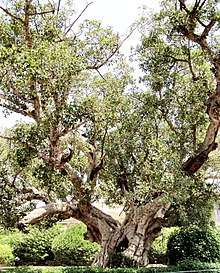 | |
| Sycamore fig, Ficus sycomorus | |
| Scientific classification | |
| Kingdom: | Plantae |
| Clade: | Tracheophytes |
| Clade: | Angiosperms |
| Clade: | Eudicots |
| Clade: | Rosids |
| Order: | Rosales |
| Family: | Moraceae |
| Tribe: | Ficeae Dumort. |
| Genus: | Ficus L. |
| Species | |
|
About 800, see text | |
Description
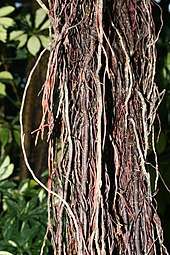
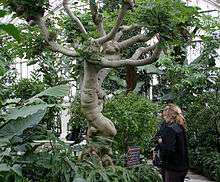
Ficus is a pantropical genus of trees, shrubs, and vines occupying a wide variety of ecological niches; most are evergreen, but some deciduous species are endemic to areas outside of the tropics and to higher elevations.[4] Fig species are characterized by their unique inflorescence and distinctive pollination syndrome, which uses wasp species belonging to the family Agaonidae for pollination.
The specific identification of many of the species can be difficult, but figs as a group are relatively easy to recognize. Many have aerial roots and a distinctive shape or habit, and their fruits distinguish them from other plants. The fig fruit is an enclosed inflorescence, sometimes referred to as a syconium, an urn-like structure lined on the inside with the fig's tiny flowers. The unique fig pollination system, involving tiny, highly specific wasps, known as fig wasps that enter via ostiole these subclosed inflorescences to both pollinate and lay their own eggs, has been a constant source of inspiration and wonder to biologists.[5] Finally, three vegetative traits together are unique to figs. All figs possess a white to yellowish latex, some in copious quantities; the twig has paired stipules or a circular stipule scar if the stipules have fallen off; and the lateral veins at the base of the leaf are steep, forming a tighter angle with the midrib than the other lateral veins, a feature referred to as "triveined".
No unambiguous older fossils of Ficus are known. However, current molecular clock estimates indicate that Ficus is a relatively ancient genus being at least 60 million years old,[5] and possibly as old as 80 million years. The main radiation of extant species, however, may have taken place more recently, between 20 and 40 million years ago.
Some better-known species that represent the diversity of the genus include the common fig, a small, temperate deciduous tree whose fingered fig leaf is well known in art and iconography; the weeping fig (F. benjamina), a hemiepiphyte with thin, tough leaves on pendulous stalks adapted to its rain forest habitat; the rough-leaved sandpaper figs from Australia; and the creeping fig (F. pumila), a vine whose small, hard leaves form a dense carpet of foliage over rocks or garden walls.
Moreover, figs with different plant habits have undergone adaptive radiation in different biogeographic regions, leading to very high levels of alpha diversity. In the tropics, Ficus commonly is the most species-rich plant genus in a particular forest. In Asia, as many as 70 or more species can co-exist.[6] Ficus species richness declines with an increase in latitude in both hemispheres.[7][8]
Ecology and uses
Figs are keystone species in many tropical forest ecosystems. Their fruit are a key resource for some frugivores including fruit bats, and primates including: capuchin monkeys, langurs, gibbons and mangabeys. They are even more important for birds such as Asian barbets, pigeons, hornbills, fig-parrots and bulbuls, which may almost entirely subsist on figs when these are in plenty. Many Lepidoptera caterpillars feed on fig leaves, for example several Euploea species (crow butterflies), the plain tiger (Danaus chrysippus), the giant swallowtail (Papilio cresphontes), the brown awl (Badamia exclamationis), and Chrysodeixis eriosoma, Choreutidae and Copromorphidae moths. The citrus long-horned beetle (Anoplophora chinensis), for example, has larvae that feed on wood, including that of fig trees; it can become a pest in fig plantations. Similarly, the sweet potato whitefly (Bemisia tabaci) is frequently found as a pest on figs grown as potted plants and is spread through the export of these plants to other localities. For a list of other diseases common to fig trees, see List of foliage plant diseases (Moraceae).
The wood of fig trees is often soft and the latex precludes its use for many purposes. It was used to make mummy caskets in Ancient Egypt. Certain fig species (mainly F. cotinifolia, F. insipida and F. padifolia) are traditionally used in Mesoamerica to produce papel amate (Nahuatl: āmatl). Mutuba (F. natalensis) is used to produce barkcloth in Uganda. Pou (F. religiosa) leaves' shape inspired one of the standard kbach rachana, decorative elements in Cambodian architecture. Indian banyan (F. bengalensis) and the Indian rubber plant, as well as other species, have use in herbalism.
Figs have figured prominently in some human cultures. There is evidence that figs, specifically the common fig (F. carica) and sycamore fig (Ficus sycomorus), were among the first – if not the very first – plant species that were deliberately bred for agriculture in the Middle East, starting more than 11,000 years ago. Nine subfossil F. carica figs dated to about 9400–9200 BCE were found in the early Neolithic village Gilgal I (in the Jordan Valley, 13 km north of Jericho). These were a parthenogenetic type and thus apparently an early cultivar. This find predates the first known cultivation of grain in the Middle East by many hundreds of years.[9]
The 1889 book 'The Useful Native Plants of Australia’ records that Ficus aspera had the common names "Rough-leaved Fig", "Purple Fig" and "White Fig" and that Indigenous Australians of the Rockhampton region referred to them as "Noomaie" and in Cleveland Bay (Queensland) "Balemo". It also states that the fruit which is black can be eaten.[10]
Fig fruit and reproduction system

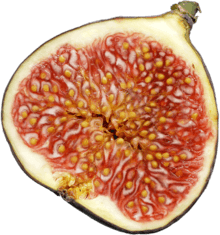
Many fig species are grown for their fruits, though only Ficus carica is cultivated to any extent for this purpose. A fig "fruit" is a type of multiple fruit known as a syconium, derived from an arrangement of many small flowers on an inverted, nearly closed receptacle. The many small flowers are unseen unless the fig is cut open.
The fruit typically has a bulbous shape with a small opening (the ostiole) at the outward end that allows access to pollinators. The flowers are pollinated by very small wasps that crawl through the opening in search of a suitable place to lay eggs. Without this pollinator service fig trees could not reproduce by seed. In turn, the flowers provide a safe haven and nourishment for the next generation of wasps. This accounts for the frequent presence of wasp larvae in the fruit, and has led to a coevolutionary relationship. Technically, a fig fruit proper would be only one of the many tiny matured, seed-bearing gynoecia found inside one fig – if you cut open a fresh fig, individual fruit will appear as fleshy "threads", each bearing a single seed inside. The genus Dorstenia, also in the fig family (Moraceae), exhibits similar tiny flowers arranged on a receptacle but in this case the receptacle is a more or less flat, open surface.
Fig plants can be monoecious (hermaphrodite) or gynodioecious (hermaphrodite and female).[11] Nearly half of fig species are gynodioecious, and therefore have some plants with inflorescences (syconium) with long styled pistillate flowers, and other plants with staminate flowers mixed with short styled pistillate flowers.[12] The long flowers styles tend to prevent wasps from laying their eggs within the ovules, while the short styled flowers are accessible for egg laying.[13]
All the native fig trees of the American continent are hermaphrodites, as well as species like Indian banyan (F. benghalensis), weeping fig (F. benjamina), Indian rubber plant (F. elastica), fiddle-leaved fig (F. lyrata), Moreton Bay fig (F. macrophylla), Chinese banyan (F. microcarpa), sacred fig (F. religiosa) and sycamore fig (F. sycomorus).[14] The common fig (Ficus carica) is a gynodioecious plant, as well as lofty fig or clown fig (F. aspera), Roxburgh fig (F. auriculata), mistletoe fig (F. deltoidea), F. pseudopalma, creeping fig (F. pumila) and related species. The hermaphrodite common figs are called "inedible figs" or "caprifigs"; in traditional culture in the Mediterranean region they were considered food for goats (Capra aegagrus). In the female fig trees, the male flower parts fail to develop; they produce the "'edible figs". Fig wasps grow in common fig caprifigs but not in the female syconiums because the female flower is too long for the wasp to successfully lay her eggs in them. Nonetheless, the wasp pollinates the flower with pollen from the caprifig it grew up in. When the wasp dies, it is broken down by enzymes (Ficain) inside the fig. Fig wasps are not known to transmit any diseases harmful to humans.
When a caprifig ripens, another caprifig must be ready to be pollinated. In temperate climes, wasps hibernate in figs, and there are distinct crops. Caprifigs have three crops per year; common figs have two.[15] The first crop (breba) is larger and more juicy, and is usually eaten fresh.[15] In cold climates the breba crop is often destroyed by spring frosts.[16] Some parthenocarpic cultivars of common figs do not require pollination at all, and will produce a crop of figs (albeit sterile) in the absence of caprifigs or fig wasps.
Depending on the species, each fruit can contain hundreds or even thousand of seeds.[17] Figs can be propagated by seeds, cuttings, air-layering or grafting. However, as with any plant, figs grown from seed are not necessarily genetically identical to the parent and are only propagated this way for breeding purposes.
Phytochemicals
Fig fruits, especially the exocarp (skin) and seeds, contain monosaccharide sugars and mixed phytochemicals, such as flavonoids, gallic acid, chlorogenic acid, rutin, and epicatechins, the contents of which are higher in dark figs compared to those in light-colored varieties.[18][19] Ripe fruits contain higher amounts of polyphenols and sugar than unripe fruits, and drying generally increases the contents of these constituents per unit of weight.[18][19]
Mutualism with the pollinating fig wasps
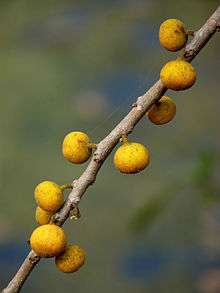
Each species of fig is pollinated by one or a few specialised wasp species, and therefore plantings of fig species outside of their native range results in effectively sterile individuals. For example, in Hawaii, some 60 species of figs have been introduced, but only four of the wasps that fertilize them have been introduced, so only four species of figs produce viable seeds there and can become invasive species. This is an example of mutualism, in which each organism (fig plant and fig wasp) benefit each other, in this case reproductively.
The intimate association between fig species and their wasp pollinators, along with the high incidence of a one-to-one plant-pollinator ratio have long led scientists to believe that figs and wasps are a clear example of coevolution. Morphological and reproductive behavior evidence, such as the correspondence between fig and wasp larvae maturation rates, have been cited as support for this hypothesis for many years.[20] Additionally, recent genetic and molecular dating analyses have shown a very close correspondence in the character evolution and speciation phylogenies of these two clades.[5]
According to meta-analysis of molecular data for 119 fig species 35% (41) have multiple pollinator wasp species. The real proportion is higher because not all wasp species were detected.[21] On the other hand, species of wasps pollinate multiple host fig species.[22] Molecular techniques, like microsatellite markers and mitochondrial sequence analysis, allowed a discovery of multiple genetically distinct, cryptic wasp species. Not all these cryptic species are sister taxa and thus must have experienced a host fig shift at some point.[23] These cryptic species lacked evidence of genetic introgression or backcrosses indicating limited fitness for hybrids and effective reproductive isolation and speciation.[23]
The existence of cryptic species suggests that neither the number of symbionts nor their evolutionary relationships are necessarily fixed ecologically. While the morphological characteristics that facilitate the fig-wasp mutualisms are likely to be shared more fully in closer relatives, the absence of unique pairings would make it impossible to do a one-to-one tree comparison and difficult to determine cospeciation.
Systematics
With 800 species, Ficus is by far the largest genus in the Moraceae, and is one of the largest genera of flowering plants currently described.[24] The species currently classified within Ficus were originally split into several genera in the mid-1800s, providing the basis for a subgeneric classification when reunited into one genus in 1867. This classification put functionally dioecious species into four subgenera based on floral characters.[25] In 1965, E. J. H. Corner reorganized the genus on the basis of breeding system, uniting these four dioecious subgenera into a single dioecious subgenus Ficus. Monoecious figs were classified within the subgenera Urostigma, Pharmacosycea and Sycomorus.[26]
This traditional classification has been called into question by recent phylogenetic studies employing genetic methods to investigate the relationships between representative members of the various sections of each subgenus.[5][25][27][28][29] Of Corner's original subgeneric divisions of the genus, only Sycomorus is supported as monophyletic in the majority of phylogenetic studies.[5][25][28] Notably, there is no clear split between dioecious and monoecious lineages.[5][25][27][28][29] One of the two sections of Pharmacosycea, a monoecious group, form a monophyletic clade basal to the rest of the genus, which includes the other section of Pharmacosycea, the rest of the monoecious species, and all of the dioecious species.[29] These remaining species are divided into two main monophyletic lineages (though the statistical support for these lineages isn't as strong as for the monophyly of the more derived clades within them). One consists of all sections of Urostigma except for section Urostigma s. s.. The other includes section Urostigma s. s., subgenus Sycomorus, and the species of subgenus Ficus, though the relationships of the sections of these groups to one another are not well resolved.[5][29]
Selected species
Subgenus Ficus
- Ficus amplissima Sm. – bat fig
- Ficus carica L. – common fig
- Ficus daimingshanensis Chang
- Ficus deltoidea Jack – mistletoe fig
- Ficus erecta Thunb. – Japanese fig
- Ficus fulva Reinw. ex Blume
- Ficus grossularioides Burman f. – white-leaved fig
- Ficus neriifolia Sm.
- Ficus palmata Forssk.
- Ficus pandurata Hance
- Ficus ischnopoda Miq.
- Ficus simplicissima Lour. (synonym Ficus hirta Vahl)
- Ficus triloba Buch.-Ham. ex Voigt
- Ficus vaccinioides King
- Ficus variolosa Lindl. ex Benth.
Subgenus Pharmacosycea
- Ficus adhatodifolia Schott
- Ficus apollinaris Dugand
- Ficus carchiana Berg
- Ficus crassiuscula Standl.
- Ficus ecuadorensis Berg
- Ficus dicranostyla Mildbr.
- Ficus gigantosyce Dugand
- Ficus guajavoides Lundell
- Ficus illiberalis Corner
- Ficus insipida Willd.
- Ficus lacunata Kvitvik
- Ficus macbridei Standl.
- Ficus maxima Mill.
- Ficus mutabilis Bureau
- Ficus mutisii Dugand
- Ficus nervosa Heyne ex Roth
- Ficus obtusiuscula Miq.
- Ficus piresiana Vázquez Avila & Berg
- Ficus pulchella Schott
- Ficus rieberiana Berg
- Ficus tonduzii Standl.
- Ficus yoponensis Desv.
Subgenus Sycidium
- Ficus andamanica Corner
- Ficus aspera G.Forst.
- Ficus bojeri Baker
- Ficus capreifolia Delile
- Ficus coronata Spin – creek sandpaper fig
- Ficus fraseri Miq. – shiny sandpaper fig
- Ficus fulvopilosa Summerh.
- Ficus godeffroyi Warb.
- Ficus greenwoodii Summerh.
- Ficus heterophylla L.f.
- Ficus lateriflora Vahl
- Ficus masonii Baker
- Ficus montana Burm.f. – oakleaf fig
- Ficus opposita Miq. – sweet sandpaper fig
- Ficus scabra G.Forst.
- Ficus tinctoria G.Forst. – dye fig
- Ficus ulmifolia Lam.
- Ficus virgata Blume
- Ficus wassa Roxb.
Subgenus Sycomorus
- Ficus auriculata Lour. – Roxburgh fig
- Ficus benguetensis Merr.
- Ficus congesta Roxb.
- Ficus dammaropsis Diels – highland breadfruit, kapiak
- Ficus fistulosa Blume
- Ficus hispida L.
- Ficus mauritiana Lam.
- Ficus minahassae Teijsmann & de Vriese
- Ficus mollior Bentham
- Ficus mucuso Welw. ex Ficalho
- Ficus nana Corner
- Ficus nota Merr. – tibig
- Ficus pseudopalma Blanco
- Ficus racemosa L. – cluster fig
- Ficus septica Burm.f. – hauli tree
- Ficus sycomorus L., 1753 – sycamore fig (Africa)
- Ficus variegata Blume
Subgenus Synoecia
The following species[30] are typically spreading or climbing lianas:
- Ficus barba-jovis Corner[31]
- Ficus hederacea Roxb.[31]
- Ficus laevis Blume[32]
- Ficus pantoniana King[33] – climbing fig
- Ficus pumila L.[32] – creeping fig
- Ficus pumila var. awkeotsang (Makino) Corner – jelly fig
- Ficus punctata Thunb.[34]
- Ficus sagittata J. König ex Vahl
- Ficus sarmentosa Buch.-Ham. ex Sm.
- Ficus trichocarpa Blume
- Ficus villosa Blume[35]
Subgenus Urostigma
- Ficus abutilifolia Miq.
- Ficus albert-smithii Standl.
- Ficus altissima Blume
- Ficus amazonica Miq.
- Ficus americana Aubl.
- Ficus aripuanensis Berg & Kooy
- Ficus arpazusa Carauta and Diaz – Brazil[36]
- Ficus aurea Nutt. – Florida strangler fig
- Ficus beddomei King – thavital
- Ficus benghalensis L. – Indian banyan
- Ficus benjamina L. – weeping fig[37]
- Ficus binnendijkii Miq.
- Ficus bizanae Hutch. & Burtt-Davy
- Ficus blepharophylla Vázquez Avila
- Ficus broadwayi Urb.
- Ficus bubu Warb.
- Ficus burtt-davyi Hutch.
- Ficus calyptroceras Miq.
- Ficus castellviana Dugand
- Ficus catappifolia Kunth & Bouché
- Ficus caulocarpa Miq.
- Ficus citrifolia Mill. – short-leaved fig
- Ficus consociata Bl.
- Ficus cordata Thunb.
- Ficus costaricana Miq.
- Ficus costata Ait.[37]
- Ficus cotinifolia Kunth
- Ficus crassipes F.M.Bailey – round-leaved banana fig
- Ficus craterostoma Mildbr. & Burret
- Ficus cyathistipula Warb.
- Ficus cyclophylla (Miq.) Miq.
- Ficus dendrocida Kunth
- Ficus depressa Bl.
- Ficus destruens F.White
- Ficus drupacea Thunb.
- Ficus elastica Hornem. – rubber plant
- Ficus elasticoides De Wild.
- Ficus enormis Miq.
- Ficus exasperata Vahl.
- Ficus faulkneriana Berg
- Ficus fergusonii (King) T.B.Worth. ex Corner
- Ficus fischeri Mildbr. & Burret
- Ficus glaberrima Blume
- Ficus glumosa Delile
- Ficus gomelleira Kunth & Bouché
- Ficus greiffiana Dugand
- Ficus guaranitica Chodat – Brazil, Paraguay and Argentina[38]
- Ficus guianensis Desv.
- Ficus hirsuta Schott
- Ficus ilicina Miq.
- Ficus kerkhovenii Valeton[39] – Johore fig
- Ficus kurzii King
- Ficus luschnathiana Miq.
- Ficus ingens Miq.
- Ficus krukovii Standl.
- Ficus lacor Buch.-Ham.
- Ficus lapathifolia Miq.
- Ficus lauretana Vázquez Avila
- Ficus lutea Vahl
- Ficus lyrata Warb. – fiddle-leaved fig
- Ficus maclellandii King – Alii fig
- Ficus macrophylla Desf. ex Pers. – Moreton Bay fig
- Ficus malacocarpa Standl.
- Ficus mariae Berg, Emygdio & Carauta
- Ficus mathewsii Miq.
- Ficus matiziana Dugand
- Ficus mexiae Standl.
- Ficus microcarpa L. – Chinese banyan
- Ficus muelleriana Berg
- Ficus natalensis Hochst. – Natal fig
- Ficus obliqua G.Forst. – small-leaved fig
- Ficus obtusifolia Kunth
- Ficus pakkensis Standl.
- Ficus pallida Vahl
- Ficus panurensis Standl.
- Ficus pertusa L.f.
- Ficus petiolaris Kunth
- Ficus pisocarpa Bl.
- Ficus platypoda Cunn. – desert fig
- Ficus pleurocarpa DC. – banana fig
- Ficus polita Vahl
- Ficus prolixa G.Forst.
- Ficus religiosa L. – sacred fig
- Ficus roraimensis Berg
- Ficus rubiginosa Desf. – Port Jackson fig
- Ficus rumphii Blume
- Ficus salicifolia Vahl – willow-leaved fig
- Ficus sansibarica Warb.
- Ficus saussureana DC.
- Ficus schippii Standl.
- Ficus schultesii Dugand
- Ficus schumacheri Griseb.
- Ficus sphenophylla Standl.
- Ficus stuhlmannii Warb.
- Ficus subcordata Bl.
- Ficus subpisocarpa Gagnep.
- Ficus subpuberula Corner
- Ficus sumatrana Miq.
- Ficus superba Miq.
- Ficus superba var. henneana (Miq.) Corner
- Ficus tettensis Hutch.
- Ficus thonningii Blume
- Ficus tremula Warb.
- Ficus trichopoda Baker
- Ficus trigona L.f.
- Ficus trigonata L.
- Ficus triradiata Corner – red-stipule fig
- Ficus umbellata Vahl
- Ficus ursina Standl.
- Ficus velutina Willd.
- Ficus verruculosa Warb.
- Ficus virens Aiton – white fig
- Ficus virens var. sublanceolata (Miq.) Corner – sour fig
- Ficus watkinsiana F.M.Bailey – Watkins's fig
Unknown subgenus
- Ficus bibracteata
- Ficus callosa Willd.
- Ficus cristobalensis
- Ficus hebetifolia
- Ficus tsjahela Burm.f.
- Ficus nymphaeifolia Mill.
Cultivation
Numerous species of fig are found in cultivation in domestic and office environments, including:[40]
- F. binnendijkii, narrow-leaf fig – hardy to 5 °C (41 °F)
- F. carica, common fig – hardy to −10 °C (14 °F). Shrub or small tree which can be grown outdoors in mild temperate regions, producing substantial harvests of fruit. Many cultivars are available.
- F. benjamina, weeping fig, ficus – hardy to 5 °C (41 °F). Widely used as an indoor plant for the home or the office. It benefits from the dry, warm atmosphere of centrally-heated interiors, and can grow to substantial heights in a favoured position. Several variegated cultivars are available.
- F. elastica, rubber plant – hardy to 10 °C (50 °F): widely cultivated as a houseplant; several cultivars with variegated leaves
- F. lyrata, fiddle-leaf fig – hardy to 10 °C (50 °F)
- F. microcarpa, Indian laurel – hardy to 10 °C (50 °F)
- F. pumila, creeping fig – hardy to 1 °C (34 °F)
- F. rubiginosa, Port Jackson fig – hardy to 10 °C (50 °F)
Cultural and spiritual significance
Fig trees have profoundly influenced culture through several religious traditions. Among the more famous species are the sacred fig tree (Pipal, bodhi, bo, or po, Ficus religiosa) and other banyan figs such as Ficus benghalensis. The oldest living plant of known planting date is a Ficus religiosa tree known as the Sri Maha Bodhi planted in the temple at Anuradhapura, Sri Lanka by King Tissa in 288 BCE. The common fig is one of two significant trees in Islam, and there is a sura in Quran named "The Fig" or At-Tin (سوره تین). In Asia, figs are important in Buddhism and Hinduism. In Jainism, the consumption of any fruit belonging to this genus is prohibited.[41] The Buddha is traditionally held to have found bodhi (enlightenment) while meditating for 49 days under a sacred fig.[42] The same species was Ashvattha, the "world tree" of Hinduism. The Plaksa Pra-sravana was said to be a fig tree between the roots of which the Sarasvati River sprang forth; it is usually held to be a sacred fig but more probably is Ficus virens. According to the Kikuyu people, sacrifices to Ngai were performed under a sycomore tree (Mũkũyũ) and if one was not available, a fig tree (Mũgumo) would be used. The common fig tree is cited in the Bible, where in Genesis 3:7, Adam and Eve cover their nakedness with fig leaves. The fig fruit is also one of the traditional crops of Israel, and is included in the list of food found in the Promised Land, according to the Torah (Deut. 8). Jesus cursed a fig tree for bearing no fruit (Mark 11:12–14). The fig tree was sacred in ancient Cyprus, where it was a symbol of fertility.
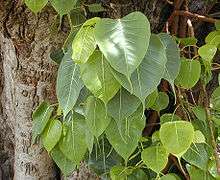 Leaves of the sacred fig (Ficus religiosa)
Leaves of the sacred fig (Ficus religiosa) Fig tree roots overgrowing a sandstone Buddha statue, near Wat Maha That in Ayutthaya province, Thailand
Fig tree roots overgrowing a sandstone Buddha statue, near Wat Maha That in Ayutthaya province, Thailand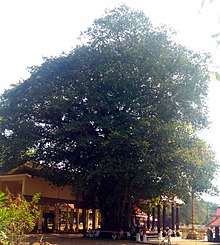
List of famous fig trees
- Ashvattha – the world tree of Hinduism, held to be a supernatural F. religiosa
- Bodhi tree – a F. religiosa
- Charybdis Fig Tree of Homer's Odyssey, presumably a F. carica
- Curtain Fig Tree – a F. virens
- Ficus Ruminalis – a F. carica
- Plaksa – another supernatural fig in Hinduism; usually identified as F. religiosa but is probably F. virens
- Santa Barbara's Moreton Bay Fig Tree – a F. macrophylla
- Sri Maha Bodhi – another F. religiosa, planted in 288 BCE, the oldest human-planted tree on record
- The Great Banyan – a F. benghalensis, a clonal colony and once the largest organism known
- Vidurashwatha – "Vidura's Sacred Fig Tree", a village in India named after a famous F. religiosa that until recently stood there
- Wonderboom – the largest fig tree in Pretoria, South Africa
Citations
- "ficus". Merriam-Webster – via merriam-webster.com.
- Sunset Western Garden Book. 1995. pp. 606–607. ISBN 978-0-37603-851-7.
- "Definition of 'ficus'". Collins English Dictionary – via collinsdictionary.com.
- Halevy, Abraham H. (1989). Handbook of Flowering Volume 6 of CRC Handbook of Flowering. CRC Press. p. 331. ISBN 978-0-8493-3916-5. Retrieved 2009-08-25.
- Rønsted et al. (2005).
- Harrison (2005).
- van Noort & van Harten (2006).
- Berg & Hijmann (1989).
- Kislev, Hartmann & Bar-Yosef (2006).
- J. H. Maiden (1889). The useful native plants of Australia : Including Tasmania. Sydney: Turner and Henderson.
- Armstrong, Wayne P; Disparti, Steven (4 April 1998). "A Key to Subgroups of Dioecious* (Gynodioecious) Figs Based On Fig Wasp/Male Syconium Pollination Patterns". Wayne's Word. Archived from the original on 2012-02-02. Retrieved 2012-01-05.
- Friis, Ib; Balslev, Henrik (2005). Plant diversity and complexity patterns: local, regional, and global dimensions. Kgl. Danske Videnskabernes Selskab. p. 472. ISBN 978-87-7304-304-2.
- Valdeyron, Georges; Lloyd, David G. (June 1979). "Sex Differences and Flowering Phenology in the Common Fig, Ficus carica L.". Evolution. 33 (2): 673–685. doi:10.2307/2407790. JSTOR 2407790. PMID 28563939.
- Berg & Corner (2005).
- Sinha, K.K. (2003). "Figs". Encyclopedia of Food Sciences and Nutrition (2nd ed.). Elsevier Science Ltd. ISBN 978-0-12-227055-0. Retrieved 2018-04-22 – via ScienceDirect: Fig Wasp.
- California Rare Fruit Growers, Inc. (1996): Fig. Retrieved November 1, 2008.
- "The Weird Sex Life of the Fig" (PDF). Ray's Figs. Retrieved 2012-01-05.
- Arvaniti, Olga S.; Samaras, Yiannis; Gatidou, Georgia; Thomaidis, Nikolaos S.; Stasinakis, Athanasios S. (2019). "Review on fresh and dried figs: Chemical analysis and occurrence of phytochemical compounds, antioxidant capacity and health effects". Food Research International. 119: 244–267. doi:10.1016/j.foodres.2019.01.055. ISSN 0963-9969. PMID 30884655.
- Slatnar, Ana; Klancar, Urska; Stampar, Franci; Veberic, Robert (9 November 2011). "Effect of drying of figs (Ficus carica L.) on the contents of sugars, organic acids, and phenolic compounds". Journal of Agricultural and Food Chemistry. 59 (21): 11696–11702. doi:10.1021/jf202707y. ISSN 0021-8561. PMID 21958361.
- Machado, C. A.; Jousselin, E.; Kjellberg, F.; Compton, S. G.; Herre, E. A. (7 April 2001). "Phylogenetic relationships, historical biogeography and character evolution of fig-pollinating wasps". Proceedings of the Royal Society B: Biological Sciences. 268 (1468): 685–694. doi:10.1098/rspb.2000.1418. PMC 1088657. PMID 11321056.
- Yang, Li-Yuan; Machado, Carlos A.; Dang, Xiao-Dong; Peng, Yan-Qiong; Yang, Da-Rong; Zhang, Da-Yong; Liao, Wan-Jin (February 2015). "The incidence and pattern of copollinator diversification in dioecious and monoecious figs". Evolution. 69 (2): 294–304. doi:10.1111/evo.12584. PMC 4328460. PMID 25495152.
- Machado, C. A.; Robbins, N.; Gilbert, M. T. P.; Herre, E. A. (3 May 2005). "Critical review of host specificity and its coevolutionary implications in the fig/fig-wasp mutualism". Proceedings of the National Academy of Sciences. 102 (Supplement 1): 6558–6565. doi:10.1073/pnas.0501840102. PMC 1131861. PMID 15851680.
- Molbo, D.; Machado, C.A.; Sevenster, J.G.; Keller, L.; Herre, E.A. (24 April 2003). "Cryptic species of fig-pollinating wasps: Implications for the evolution of the fig-wasp mutualism, sex allocation, and precision of adaptation". Proceedings of the National Academy of Sciences. 100 (10): 5867–5872. doi:10.1073/pnas.0930903100. PMC 156293. PMID 12714682.
- Judd, W.S.; Campbell, C.S.; Kellogg, E.A.; Stevens, P.F.; Donoghue, M.J. (2008). Plant Systematics: A phylogenetic approach (3rd ed.). Sunderland (Massachusetts): Sinauer Associates. ISBN 978-0-87893-407-2.
- Weiblen, G.D. (2000). "Phylogenetic relationships of functionally dioecious Ficus (Moraceae) based on ribosomal DNA sequences and morphology" (PDF). American Journal of Botany. 87 (9): 1342–1357. doi:10.2307/2656726. JSTOR 2656726. Retrieved 2018-04-22.
- Corner, E.J.H. (1965). "Check-list of Ficus in Asia and Australasia with keys to identification". The Gardens' Bulletin Singapore. 21 (1): 1–186. Retrieved 5 Feb 2014 – via biodiversitylibrary.org.
- Herre, E.; Machado, C.A.; Bermingham, E.; Nason, J.D.; Windsor, D.M.; McCafferty, S.; Van Houten, W.; Bachmann, K. (1996). "Molecular phylogenies of figs and their pollinator wasps". Journal of Biogeography. 23 (4): 521–530. doi:10.1111/j.1365-2699.1996.tb00014.x.
- Jousselin, E.; Rasplus, J.-Y.; Kjellberg, F. (2003). "Convergence and coevolution in a mutualism: evidence from a molecular phylogeny of Ficus". Evolution; International Journal of Organic Evolution. 57 (6): 1255–1269. doi:10.1554/02-445. PMID 12894934.
- Rønsted et al. (2008).
- Berg (2003).
- Berg (2003), p. 552.
- Berg (2003), p. 553.
- Berg (2003), p. 554.
- Berg (2003), pp. 565.
- Berg (2003), pp. 553–554.
- Carauta & Diaz (2002), pp. 38–39.
- van Noort, S.; Rasplus, J.Y. (2020). "Subsection Conosycea". Figweb: figs and fig wasps of the world. Retrieved 11 August 2019.
- Carauta & Diaz (2002), pp. 64–66.
- Joseph Lai; Angie Ng; Chuah Ai Lin; Marilyn Cheng (12 September 2002). "Significant Trees and Shrubs in Changi". Retrieved 2012-01-05.
- Brickell, Christopher, ed. (2008). The Royal Horticultural Society A-Z Encyclopedia of Garden Plants. United Kingdom: Dorling Kindersley. p. 448. ISBN 9781405332965.
- Tukol, T.K. (1980). Compendium of Jainism. Prasaranga: Karnatak University. p. 206.
- "The Bodhi Tree: Uniting all Worlds". Buddhists.org. Retrieved 17 January 2020.
General references
- Berg, C.C. (28 November 2003). "Flora Malesiana Precursor for the Treatment of Moraceae 4: Ficus subgenus Synoecia". Blumea. 48 (3): 551–571. doi:10.3767/000651903X489546.
- Berg, C.C.; Hijmann, M.E.E. (1989). "Chapter 11: Ficus". In R.M. Polhill (ed.). Flora of Tropical East Africa. pp. 43–86.
- Berg, C.C.; Corner, E.J.H. (2005). Flora malesiana. Series I, Seed plants. Volume 17. Part 2, Moraceae (Ficus). Leiden: National herbarium Nederland, Universiteit Leiden branch. ISBN 978-9-07123-661-7. OCLC 492578589.
- Carauta, Pedro; Diaz, Ernani (2002). Figueiras no Brasil. Rio de Janeiro: Editora UFRJ. ISBN 978-85-7108-250-2.
- Condit, Ira J (1969). Ficus: the exotic species. University of California, Division of Agricultural Sciences. OCLC 1086743649.
- Denisowski, Paul (2007). "Fig". Chinese–English Dictionary. Retrieved November 1, 2008.
- Harrison, Rhett D (2005). "Figs and the diversity of tropical rain forests" (PDF). BioScience. 55 (12): 1053–1064. doi:10.1641/0006-3568(2005)055[1053:FATDOT]2.0.CO;2.
- Kislev, Mordechai E.; Hartmann, Anat; Bar-Yosef, Ofer (2006). "Early Domesticated Fig in the Jordan Valley". Science. 312 (5778): 1372–1374. doi:10.1126/science.1125910. PMID 16741119. Supporting Online Material
- Kislev, Mordechai E.; Hartmann, Anat; Bar-Yosef, Ofer (2006). "Response to Comment on "Early Domesticated Fig in the Jordan Valley"". Science. 314 (5806): 1683b. doi:10.1126/science.1133748.
- Lev-Yadun, Simcha; Ne'eman, Gidi; Abbo, Shahal; Flaishman, Moshe A (2006). "Comment on "Early Domesticated Fig in the Jordan Valley"". Science. 314 (5806): 1683a. doi:10.1126/science.1132636. PMID 17170278.
- Lewington, Anna; Parker, Edward (1999). Ancient trees: Trees that live for 1000 years. London: Collins & Brown. ISBN 978-18-5585-704-9.
- Rønsted, Nina; Weiblen, George D.; Cook, James M.; Salamin, Nicholas; Machado, Carlos A.; Savoainen, Vincent (2005). "60 million years of co-divergence in the fig-wasp symbiosis". Proceedings of the Royal Society B: Biological Sciences. 272 (1581): 2593–2599. doi:10.1098/rspb.2005.3249. PMC 1559977. PMID 16321781.
- Rønsted, N; Weiblen, G.D.; Clement, W.L.; Zerega, N.J.C.; Savolainen, V. (2008). "Reconstructing the phylogeny of figs (Ficus, Moraceae) to reveal the history of the fig pollination mutualism" (PDF). Symbiosis. 45. ISSN 0334-5114.
- Shanahan, M.; Compton, S. G.; So, Samson; Corlett, Richard (2001). "Fig-eating by vertebrate frugivores: a global review". Biological Reviews. 76 (4): 529–572. doi:10.1017/S1464793101005760. PMID 11762492. Electronic appendices
- van Noort, Simon; van Harten, Antonius (2006). "The species richness of fig wasps (Hymenoptera: Chalcidoidea: Agaonidae, Pteromalidae) in Yemen". Fauna of Arabia. 22: 449–472. Retrieved 2013-01-01.
External links
| Wikimedia Commons has media related to Ficus. |
- Figweb—Major reference site for the genus Ficus
- World checklist of Ficus species from the Catalogue of Life, 845 species supplied by M. Hassler’s World Plants.
- Video: Interaction of figs and fig wasps—Multi-award-winning documentary
- Fruits of Warm Climates: Fig
- BBC: Fig fossil clue to early farming
Video